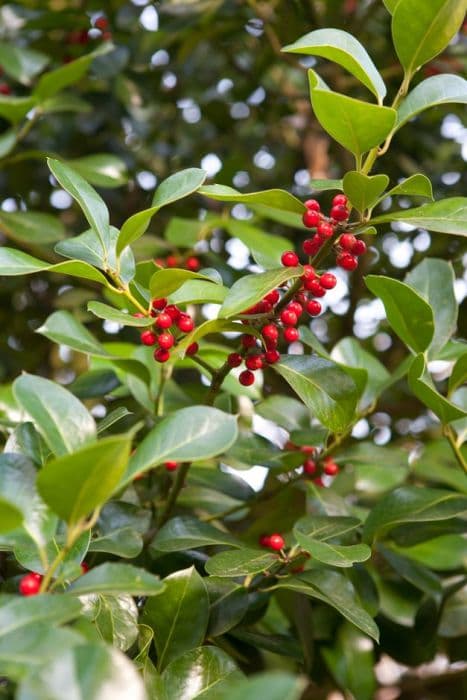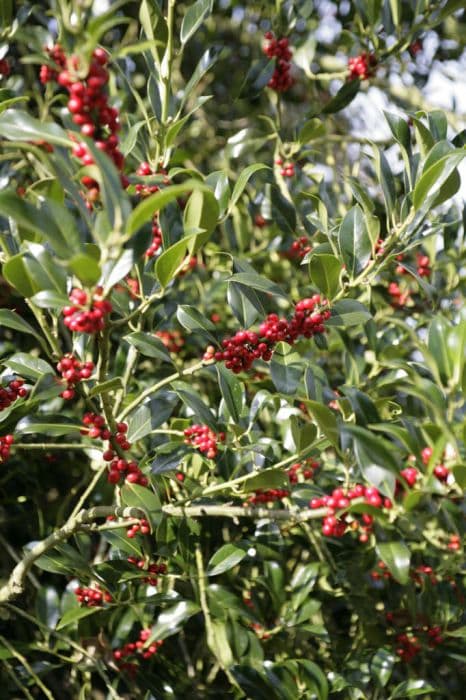Yellow-berried European Holly Ilex aquifolium 'Pyramidalis Fructu Luteo' (f)

ABOUT
The holly 'Pyramidalis Fructu Luteo' is a striking evergreen plant known for its unique foliage and fruit features. It has glossy, dark green leaves with a distinctive spiky edge that is reminiscent of the classic holly leaf shape. Each leaf is adorned with spines along the margin, contributing to its visual impact in the garden. What sets this variety apart are its cheerful yellow berries, which stand out brightly against the dark foliage, adding a splash of color, especially during the colder months when other plants have lost their leaves or blooms. These fruits emerge following small, white flowers which bloom in the spring. The plant has a columnar or pyramidal shape, giving it an architectural presence that can add structure to garden compositions.
About this plant
 Names
NamesFamily
Aquifoliaceae
Synonyms
Yellow-Fruited Holly, Golden Berry Holly
Common names
Ilex aquifolium 'Pyramidalis Fructu Luteo'
 Toxicity
ToxicityTo humans
The English Holly is considered to be toxic to humans. The berries and leaves contain several toxic substances including theobromine, an alkaloid that is also found in chocolate. If ingested, symptoms of poisoning can include nausea, vomiting, diarrhea, and abdominal pain. In severe cases, ingestion can lead to drowsiness, dehydration, and in very rare instances, even death, particularly in children due to their smaller body size.
To pets
The English Holly is also toxic to pets, including dogs and cats. The plant contains saponins, methylxanthines, and cyanogenic glycosides which can cause gastrointestinal upset if ingested. Symptoms of toxicity in pets can include vomiting, diarrhea, hypersalivation, and lethargy. In severe cases, if a significant amount of the plant is consumed, it can cause dehydration, drowsiness, and potentially be life-threatening, warranting immediate veterinary attention.
 Characteristics
CharacteristicsLife cycle
Perennials
Foliage type
Evergreen
Color of leaves
Green
Flower color
White
Height
6-10 feet (1.8-3 meters)
Spread
4-6 feet (1.2-1.8 meters)
Plant type
Shrub
Hardiness zones
5-9
Native area
Europe
Benefits
 General Benefits
General Benefits- Attractive Foliage: The plant's glossy, green leaves with spiny edges add visual interest to gardens.
- Year-Round Interest: Maintains leaves throughout all seasons, offering continuous greenery.
- Wildlife Support: Provides habitat and food for birds with its berry-like fruits.
- Drought Resistance: Once established, the plant is relatively resilient to periods of drought.
- Low Maintenance: Requires minimal pruning and care once established in an appropriate site.
- Architectural Form: The pyramidal shape adds structure and formality to landscaping designs.
- Decorative Fruit: The yellow berries (exclusive to this female cultivar) add a splash of color and contrast against the dark green leaves.
- Tolerant of Shade: Grows well in shaded areas where other plants might struggle.
- Hedge and Barrier: Can be used to create a dense, prickly hedge that deters intruders while providing privacy.
- Cultural Significance: Often associated with Christmas and winter decorations.
- Versatility in Landscaping: Can be planted in garden beds, borders, or as a standalone specimen.
 Medical Properties
Medical PropertiesThis plant is not used for medical purposes.
 Air-purifying Qualities
Air-purifying QualitiesThis plant is not specifically known for air purifying qualities.
 Other Uses
Other Uses- The wood of English Holly is often used for making chess pieces, particularly the white pieces, due to its fine grain and ability to be polished to a high shine.
- With its dense, evergreen foliage, English Holly can be utilized as a natural screen or hedge to increase privacy in gardens and landscapes.
- Because of its association with Christmas, the plant is frequently used as a motif in Christmas carols, decorations, and greeting cards.
- English Holly's stiff, glossy leaves are used in the craft industry for creating ornamental wreaths and festive garlands.
- The trees are occasionally grown for use in topiary to create intricate designs due to their ability to sustain close clipping and maintain a dense form.
- The colorful berries can be used as a natural dye, producing colors ranging from yellow to purples and blacks depending on the mordant used.
- In folklore practices, branches of English Holly are carried by individuals as a protective charm against negative energies and evil spirits.
- The plant's wood has been traditionally used in the manufacture of walking sticks due to its toughness and durability.
- During winter, English Holly's persistent berries provide a vital food source for numerous bird species when the ground is frozen and food is scarce.
- In some cultural ceremonies, English Holly branches may be used symbolically to represent various themes, such as fertility, eternal life, or as a ward against witches and bad luck.
Interesting Facts
 Feng Shui
Feng ShuiThe Yellow-Berried Holly is not used in Feng Shui practice.
 Zodiac Sign Compitability
Zodiac Sign CompitabilityThe Yellow-Berried Holly is not used in astrology practice.
 Plant Symbolism
Plant Symbolism- Protection: The Ilex aquifolium, commonly known as the English Holly, has spiky leaves that were believed to ward off evil spirits and thus symbolize protection.
- Good Fortune: English Holly is also considered a symbol of good luck and prosperity. Having holly plants around the home, especially during winter, is thought to bring good fortune.
- Perseverance: The holly's ability to remain green throughout the harsh winter season makes it a symbol of perseverance and resilience.
- Eternal Life: The evergreen nature of English Holly symbolizes eternal life, reflecting a belief in life continuing beyond the physical existence.
- Peace: Historically, holly was used to decorate homes during winter festivals as a gesture of peace and goodwill, symbolizing a truce among enemies.
- Fertility: With its rich green leaves and bright red berries, English Holly is often associated with fertility and the vitality of life.
- Christmas: Its association with Christmas makes English Holly a symbol of the festive spirit and religious celebrations of the Christian holiday.
 Water
WaterThe Yellow-berried English Holly should be watered deeply, allowing the soil to become moderately dry between waterings. During the growing season, usually spring through summer, water the plant about once a week with approximately 1-2 gallons depending on the size of the plant and the weather conditions. In the fall and winter months, reduce the frequency to once every 2-3 weeks, as the plant's water requirements decrease. Avoid overwatering, as this can lead to root rot.
 Light
LightYellow-berried English Holly thrives best in full sun to partial shade. It should be placed in a location where it can receive at least 4 to 6 hours of direct sunlight each day. In regions with very hot summers, some afternoon shade can be beneficial to prevent leaf scorch.
 Temperature
TemperatureYellow-berried English Holly can tolerate a wide range of temperatures but prefers a cool to moderate climate. It can survive in temperatures as low as -10°F and as high as 90°F, making it quite hardy. Ideally, it should be grown in conditions where the temperature stays within 30°F to 70°F for optimal growth.
 Pruning
PruningPruning the Yellow-berried English Holly is important for shaping the plant and encouraging bushier growth. The best time to prune is in the late winter or early spring before new growth starts. Prune selectively to maintain its pyramidal form and to remove any damaged or diseased branches. Pruning can be done annually or as needed to maintain its shape and health.
 Cleaning
CleaningAs needed
 Soil
SoilThe Yellow-Berried English Holly thrives in well-draining, loamy soil with a pH of 5.0 to 6.0. A mix of two parts loam, one part peat moss, and one part sand or perlite provides an ideal growing medium for this variety.
 Repotting
RepottingYellow-Berried English Holly should be repotted every 2 to 3 years to prevent root crowding and refresh the soil. Younger plants may require more frequent repotting, while mature plants can be repotted less often.
 Humidity & Misting
Humidity & MistingYellow-Berried English Holly prefers moderate to high humidity, ideally ranging from 50% to 60%. Avoid placing in excessively dry environments, as this can lead to leaf drop.
 Suitable locations
Suitable locationsIndoor
Place near a sunny window, maintain moderate humidity.
Outdoor
Choose a partially shaded spot; shelter from harsh winds.
Hardiness zone
6-9 USDA
 Life cycle
Life cycleIlex aquifolium 'Pyramidalis Fructu Luteo', commonly known as the Golden-fruited Blue Holly, begins its life as a seed, which under suitable conditions germinates in moist, well-drained soil. It emerges as a seedling with typical holly-shaped leaves, which are spiny and dark green. As it matures into a juvenile plant, it develops a pyramidal growth habit and continues to produce its evergreen foliage, which is a key characteristic of the plant. The plant enters its reproductive stage when it's mature enough to flower, usually in late spring, displaying small, white flowers that are pollinated by bees and other insects. If pollination is successful, the female plant will produce the distinctive golden-yellow berries, which persist through fall and into winter, providing food for birds and wildlife. Finally, after many years, the plant reaches its full mature size, potentially reaching up to 2-3 meters in height, and continues its growth and reproductive cycle until the end of its lifespan, which can be several decades under optimal conditions.
 Propogation
PropogationPropogation time
Early Spring
The English Holly 'Pyramidalis Fructu Luteo', a variety known for its yellow berries, is typically propagated via seed or cuttings, with the latter being the more popular method. To propagate by cuttings, one would take semi-hardwood cuttings from a healthy parent plant during the late summer. These cuttings should be about 6 to 8 inches long and include several sets of leaves. The bottom leaves are removed, and the cut end is dipped into a rooting hormone to enhance root development. The treated cutting is then planted in a well-draining potting mix and kept under high humidity and indirect light until roots have established, which can take several weeks to months. It is essential to maintain consistent moisture and to be patient, as holly can be slow to root.









